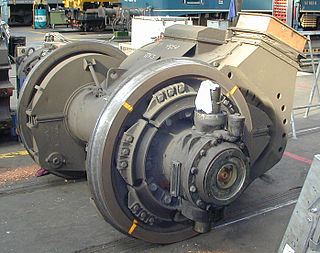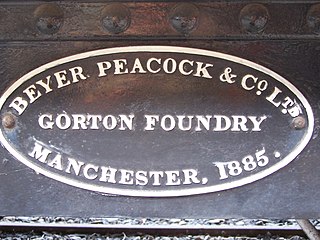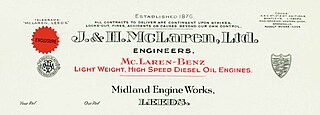
Engine number may refer to an identification number marked on the engine of a vehicle or, in the case of locomotives, to the road number of the locomotive. The engine number is separate from the Vehicle Identification Number (VIN).

Engine number may refer to an identification number marked on the engine of a vehicle or, in the case of locomotives, to the road number of the locomotive. The engine number is separate from the Vehicle Identification Number (VIN).
Every vehicle engine is marked with an engine number by the factory. [1] [2] The engine number includes coded information, which can be decoded to reveal, for example, year of manufacture, country of manufacture, and engine type. [3]
The term is also used in train terminology. [4] In this instance, it refers to the road number assigned to motive power by the operator, as opposed to a constructor's or builder's number (equivalent to a vehicle VIN number).

A locomotive or engine is a rail transport vehicle that provides the motive power for a train. If a locomotive is capable of carrying a payload, it is usually rather referred to as a multiple unit, motor coach, railcar or power car; the use of these self-propelled vehicles is increasingly common for passenger trains, but rare for freight trains.

A vehicle identification number (VIN) (also called a chassis number or frame number) is a unique code, including a serial number, used by the automotive industry to identify individual motor vehicles, towed vehicles, motorcycles, scooters and mopeds, as defined by the International Organization for Standardization in ISO 3779 (content and structure) and ISO 4030 (location and attachment).

The American Locomotive Company was an American manufacturer that operated from 1901 to 1969, initially specializing in the production of locomotives but later diversifying and fabricating at various times diesel generators, automobiles, steel, tanks, munitions, oil-production equipment, as well as heat exchangers for nuclear power plants.

Baldwin Locomotive Works (BLW) was an American manufacturer of railway locomotives from 1825 to 1951. Originally located in Philadelphia, Pennsylvania, it moved to nearby Eddystone in the early 20th century. The company was for decades the world's largest producer of steam locomotives, but struggled to compete when demand switched to diesel locomotives. Baldwin produced the last of its 70,000-plus locomotives in 1951, before merging with the Lima-Hamilton Corporation on September 11, 1951, to form the Baldwin-Lima-Hamilton Corporation.

On a steam locomotive, a driving wheel is a powered wheel which is driven by the locomotive's pistons. On a conventional, non-articulated locomotive, the driving wheels are all coupled together with side rods ; normally one pair is directly driven by the main rod which is connected to the end of the piston rod; power is transmitted to the others through the side rods.
Rail transport terms are a form of technical terminology applied to railways. Although many terms are uniform across different nations and companies, they are by no means universal, with differences often originating from parallel development of rail transport systems in different parts of the world, and in the national origins of the engineers and managers who built the inaugural rail infrastructure. An example is the term railroad, used in North America, and railway, generally used in English-speaking countries outside North America and by the International Union of Railways. In English-speaking countries outside the United Kingdom, a mixture of US and UK terms may exist.
Brush Traction was a manufacturer and maintainer of railway locomotives in Loughborough, England whose operations have now been merged into the Wabtec company's Doncaster UK operations.

The DMC DeLorean is a rear-engine two-passenger sports car manufactured and marketed by John DeLorean's DeLorean Motor Company (DMC) for the American market from 1981 until 1983—ultimately the only car brought to market by the fledgling company. The DeLorean is sometimes referred to by its internal DMC pre-production designation, DMC-12. However, the DMC-12 name was never used in sales or marketing materials for the production model.

Beyer, Peacock and Company was an English general engineering company and railway locomotive manufacturer with a factory in Openshaw, Manchester. Charles Beyer, Richard Peacock and Henry Robertson founded the company in 1854. The company closed its railway operations in the early 1960s. It retained its stock market listing until 1976, when it was bought and absorbed by National Chemical Industries of Saudi Arabia.

The Consolidation Line was a series of diesel-electric railway locomotive designs produced by Fairbanks-Morse and its Canadian licensee, the Canadian Locomotive Company. Railfans have dubbed these locomotives “C-liners”, however F-M referred to the models collectively as the C-Line. A combined total of 165 units were produced by F-M and the CLC between 1950 and 1955.

W. G. Bagnall was a locomotive manufacturer from Stafford, England which was founded in 1875 and operated until it was taken over in 1962 by English Electric.
The FM H-12-46 was a light road switcher of Fairbanks-Morse design manufactured exclusively by the Canadian Locomotive Company from October, 1951–January, 1953 for the Canadian National Railway. Only thirty of the 1,200 hp, six-cylinder opposed piston engine locomotives were produced. The units were configured in an A1A-A1A wheel arrangement, mounted atop a pair of three-axle trucks.
This article contains a list of terms, jargon, and slang used to varying degrees by railfans and railroad employees in the United States and Canada. Although not exhaustive, many of the entries in this list appear from time to time in specialist, rail-related publications. Inclusion of a term in this list does not necessarily imply its universal adoption by all railfans and railroad employees, and there may be significant regional variation in usage.

The GWR 388 class was a large class of 310 0-6-0 goods locomotives built by the Great Western Railway. They are sometimes referred to as the Armstrong Goods or Armstrong Standard Goods to differentiate from the Gooch Goods and Dean Goods classes, both of which were also large classes of standard goods locomotives.

J&H McLaren was a British engineering company in Hunslet, Leeds, England, that manufactured traction engines, stationary engines and later, diesel engines.
A builder's plate is usually a metal plate that is attached to railway locomotives and rolling stock, bogies, construction equipment, trucks, automobiles, large household appliances, bridges, ships and more. It gives such information as the name of the manufacturer, the place and country of manufacture, the model number, the serial number, as well as the date of manufacture or date of fabrication of the item or unit.
The Go package was a factory option that included various performance equipment that was available on several muscle cars manufactured by American Motors Corporation (AMC).